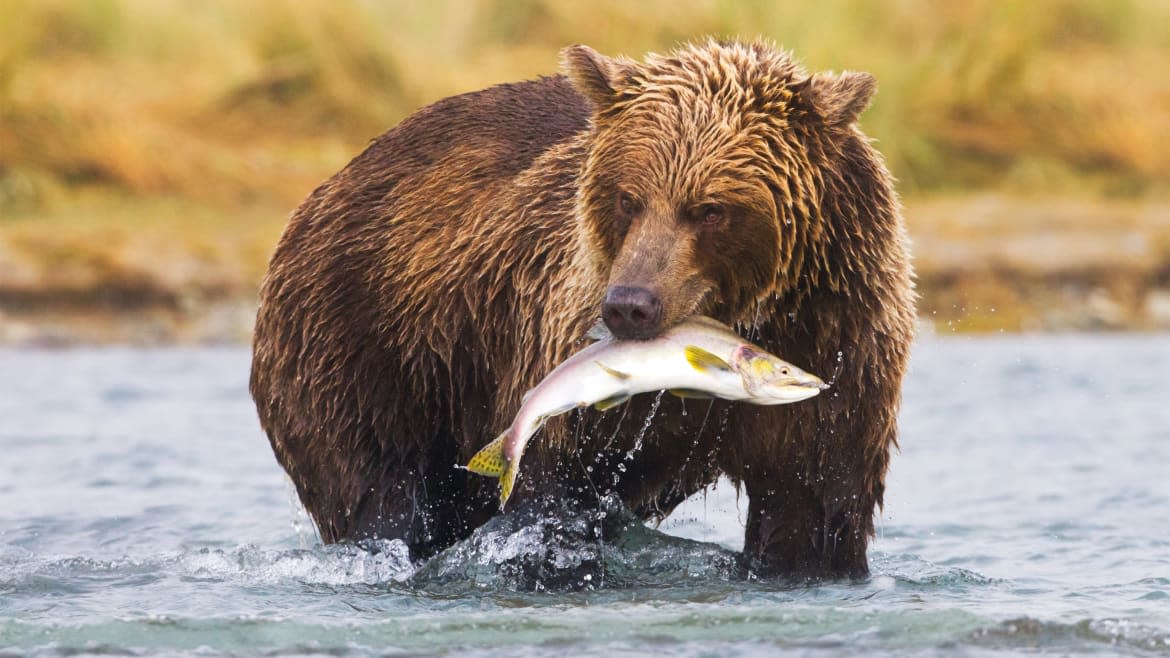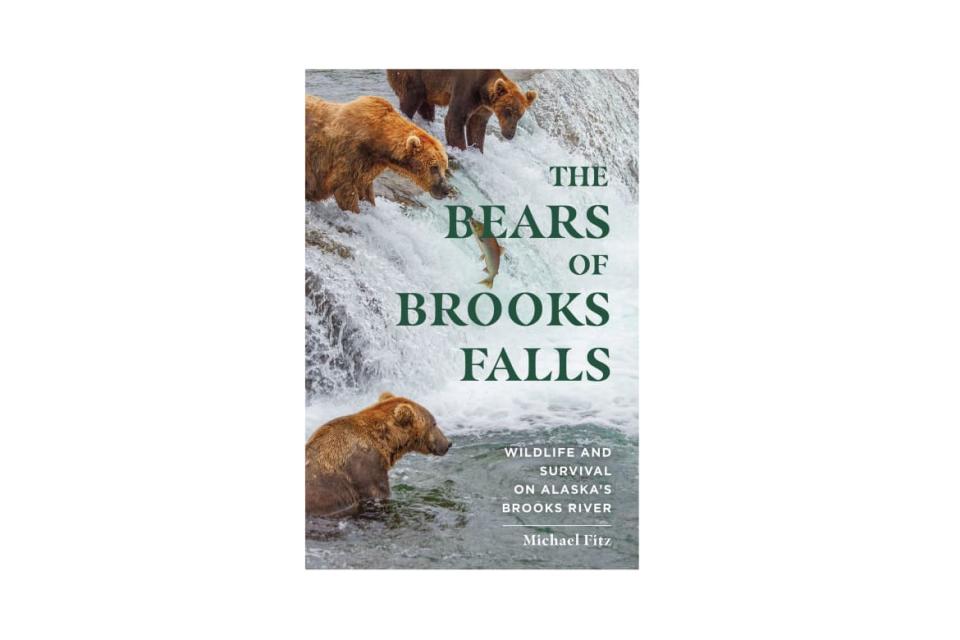Nature’s Best Eating Competition? Brown Bears

Partly eaten salmon carcasses litter the riverbank and ring the downstream island. Each second, several salmon launch out of the water in their attempt to leap the falls. Only the giant 747 is fishing when I arrive to observe, but it’s clearly been a very good day for hungry bears.
During the peak of the salmon migration, bears rarely fish alone and 747 is soon joined by an even more experienced bear. Reaching the far bank, Otis promptly lays down in the river, letting the water cool his flanks. For several minutes he doesn’t move except to place his face under the water to casually search for fish. With drooping eyelids and a downwardly nodding head, Otis appears groggy, enough so that my wife and I joke he might fall asleep in the water. Rather than a nap, Otis apparently has something else on his mind. He shakes off his sleepiness and moves slowly toward one of his most preferred fishing spots, the jacuzzi.
A borderline adult when he was first identified in 2001, Otis has become one of the oldest and most skilled bears using the falls. Tall and lean, with blond early summer fur and a floppy right ear, he stands out among the consort of adult males at the river. Otis understands he cannot challenge 747 for the jacuzzi, so he waits downstream. When 747 moves into the forest, perhaps to rest and digest his earnings, Otis fills the vacancy. Settling into the plunge pool, he sits statuesque, facing upstream with only his head, shoulders, and upper back exposed above water. The jacuzzi offers no visibility to see the salmon in the water, but Otis makes no effort to place himself in a different position. He has no need. He knows exactly what he is doing.
When a salmon bumps into his body, disoriented by the churning water or forced there by another fish, Otis snaps into action. His reflexes are quick and precise. Pinning the fish to the river gravel or his body, he plunges his muzzle into the water to secure his catch.
I watch, impressed and curious, as his catch rate grows quickly, from 1 to 5 to 10 to 15 before 747 returns and retakes the jacuzzi. The elder bear gives a modest growl but easily yields. No matter, though. Otis sees opportunity elsewhere.
Otis’s catch rate slows only slightly at this new location. Soon, it climbs to 20 then 25, then beyond 30. When I leave the falls that evening, I’m left awed by the capacity of his stomach. Otis caught and ate most of 35 salmon in about five hours. The webcam audience continues to track his success rate after I depart, observing Otis eating another seven salmon before he retires for the night. In total, he ate all or most of 42 fish—the most salmon I’ve ever observed a bear eat in a single sitting.
A bear fishing for salmon has become an almost clichéd representation of the species, yet most bear populations survive without much or any fish on the menu, or without much meat at all.
A casual list of brown bear foods from any one area includes dozens of species. A more comprehensive inventory would comprise hundreds. In Yellowstone, grizzly bears usurp elk and bison carcasses from wolves, climb mountains to feast on moths in barren scree, use their sense of smell to locate underground truffles, search meadows for seeds carefully cached by rodents, smash open the cones of whitebark pine to extract the fat-rich nuts, and raid underground ant colonies, lapping up larvae and futilely defending adults just as readily as we dig a spoon into a bowl of ice cream.
Grizzlies in the northern Rocky Mountains include some 200 plants in their diet and gain 90 percent of their annual energy from plant matter. Early in the growing season, they’ll swallow mouthfuls of green forbs and till subalpine meadows seeking roots and tubers. In late summer, they vacuum thousands of blueberries off the stem at rates that exceed the most skillful bare-handed human pickers.
The diet of bears on the Alaska Peninsula is no less varied, although it relies on a different suite of foods. They eat carrion, bird eggs, birds, voles, ground squirrels, moose, caribou, other bears, and beavers. They graze on herbaceous plants such as seacoast angelica, seaside plantain, cow parsnip, grasses, and sedges. Late summer is typically berry season in Katmai when bear scat turns black, blue, and maroon with the remnants of blueberries, crowberries, lingonberries, elderberries, highbush cranberry, watermelon berry, and currants. On the coast of the park, virtually any animal is on the menu including sea otters, harbor seals, dead whales, clams, mussels, barnacles, and beach fleas. They relish fish, especially salmon of course, yet their own vomit and human feces aren’t too taboo to cross off the menu. If bears were as widespread across the planet as humans, then the diversity of their diet might exceed our own.
Salmon are, on average, the richest and most nutritious food for Katmai’s bears, and bears will go to great effort to catch them. Most bears that fish at Brooks Falls are regulars like Otis who come back year after year. Most rare though, is the arrival of a fully mature adult, one with no prior history at the falls, who decides to stay. Watching these bears try to fish the falls and navigate its sleuth of bears illustrates how powerful a motivator hunger can be and how well bears adapt to new situations.
On a rainy evening in mid-July 2015, I watch a patchy-furred bear emerge from the trees and bound toward the waterfall. His muzzle is short and blocky, a large wound mars his right flank, and his body lacks the bulk of the other adults who had spent the last three weeks fishing here. Most noticeably, his left ear is about half the size of his right. It’s Lefty, a bear that until this day had only been seen regularly in late summer and fall, and one I never had the opportunity to watch before.
Lefty’s behavior that evening strongly suggested he had no significant experience fishing the falls or interacting with its gathering of bears. The season was also young enough that Brooks River was still the only place to catch fish, so Lefty arrived hungry. He dashes from place to place, distracted by every fish that catches his glance. He confronts almost every bear without regard to their place in the hierarchy. He moves from the lip of the falls to the far pool, where he encounters an older, nearly 27-year-old female, 410, and promptly steals her salmon. Motivated by the success, he tries the same move with 856, who is not intimidated by the newcomer’s growling approach. But the failure doesn’t stop his spree. Continuing on, he returns to 410’s vicinity and steals another of her salmon, then one from Otis, and yet another from 410.
He eats with vigor, consuming each salmon in a few large gulps. Yet the few fish he’s gathered so far aren’t nearly enough to satisfy him. He moves to the lip again where an adult female had just finished eating her catch. He trades blows with her and then forces her to slide over the edge of the waterfall.
Lefty has the lip to himself, but he seems unsure what to do next. He weaves his head, pantomiming the movement of the salmon swirling in the pool below, and might have been able to catch a few of the jumping salmon if he could have stood still, but he couldn’t. Looking down on the fish, he bobs his head upward once, twice, then leaps off the waterfall into the pool below. Although unsuccessful, it’s a belly flop for the ages.
On July 20, I again watch Lefty walk to the lip. He places his front paws on the cusp of the falls and . . . waits there patiently. Within a minute of arriving, he’s rewarded. He snaps his jaws shut on a leaping salmon.
His focused routine developed quickly after his initial arrival, just five days removed from his incessant attempts to steal fish and his frantic belly flop. Ever since, Lefty has remained a skilled and proficient angler on the lip, albeit with a continued look of excitement and expectation.

Adapted Excerpt from The Bears of Brooks Falls: Wildlife and Survival on Alaska’s Brooks River. Copyright © 2021 by Michael Fitz. Reproduced by permission of The Countryman Press, a Division of W.W. Norton & Company. All rights reserved.
Get our top stories in your inbox every day. Sign up now!
Daily Beast Membership: Beast Inside goes deeper on the stories that matter to you. Learn more.
